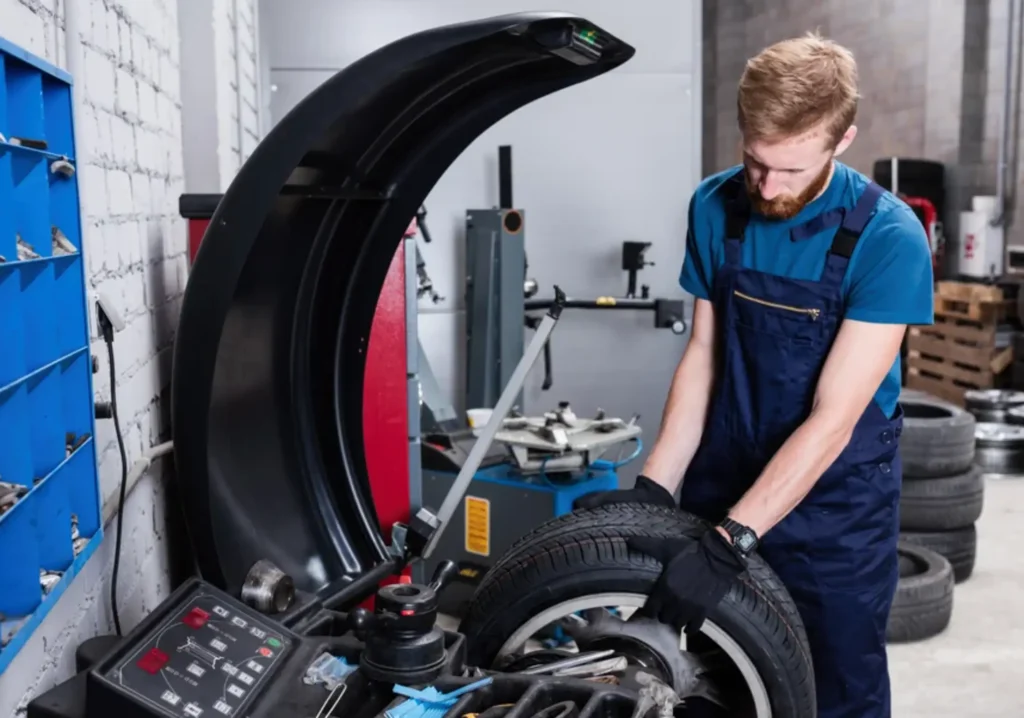Introduction to Proper Tire Rotation and Balancing
As a responsible driver, ensuring your vehicle’s optimal performance and safety should be a top priority. One of the most crucial aspects of vehicle maintenance is proper tire rotation and balancing. This comprehensive guide will explore everything you need to know about this essential practice, helping you extend the life of your tires, improve fuel efficiency, and enhance overall driving safety.
Understanding Tire Rotation
Tire rotation is the practice of systematically moving tires from one position on a vehicle to another. The primary goal of proper tire rotation and balancing is to ensure even wear across all four tires, extending their lifespan and maintaining optimal performance.
To better understand tire rotation patterns, let’s examine the following diagram:
[Image description: A diagram showing three tire rotation patterns labeled Figure A, B, and C. Each pattern shows the movement of tires from front to rear positions using blue arrows.]

This diagram illustrates three common tire rotation patterns:
- Figure A – Rearward Cross: This pattern is typically used for rear-wheel and four-wheel drive vehicles. The rear tires move straight forward, while the front tires move diagonally to the rear.
- Figure B – X-Pattern: This versatile pattern can be used for various vehicle types. All tires are moved diagonally, creating an “X” shape in the movement pattern.
- Figure C – Forward Cross: This pattern is recommended for front-wheel drive vehicles. The front tires move straight back, while the rear tires move diagonally to the front positions.
The choice of rotation pattern depends on your vehicle’s drivetrain type (front-wheel, rear-wheel, or four-wheel drive) and whether your tires are directional or non-directional. Proper tire rotation and balancing using the correct pattern for your vehicle is crucial for maximizing tire life and maintaining optimal performance.
| Benefits of Tire Rotation | Benefits of Regular Tire Rotation and Balancing |
| 1. Extended tire life 2. Improved vehicle handling 3. Enhanced fuel efficiency 4. Reduced risk of flat tires and blowouts 5. Smoother and quieter ride | 1. Cost savings on premature tire replacements 2. Improved vehicle stability and control 3. Maintained warranty coverage for your tires 4. Better traction in various weather conditions 5. Increased safety for you and your passengers |
Tire Rotation Basics

Tire Rotation Frequency
To maintain optimal performance, it’s essential to follow a regular tire rotation schedule. Most experts recommend performing proper tire rotation and balancing every 5,000 to 8,000 miles or every six months, whichever comes first. However, always consult your vehicle’s owner’s manual for specific recommendations.

Tire Rotation Patterns
There are several tire rotation patterns, and the appropriate one depends on your vehicle’s drivetrain and tire type. Common patterns include:
- Forward Cross
- X-Pattern
- Rearward Cross
- Side-to-Side
Front Wheel Drive Tire Rotation
For front-wheel-drive vehicles, a common proper tire rotation and balancing pattern is the Forward Cross:
- Move the front tires straight back to the rear axle
- Move the rear tires diagonally to the front, with the left rear going to the right front and the right rear going to the left front
Best Way to Rotate Tires for Even Wear
To ensure even wear through proper tire rotation and balancing:
- Follow the recommended rotation pattern for your vehicle
- Maintain proper tire pressure
- Address any alignment issues promptly
- Rotate tires at the recommended intervals
All About Tire Balancing
Tire balancing is the process of equalizing the weight distribution around a tire and wheel assembly. Proper tire rotation and balancing work together to ensure even wear and optimal performance.

Tire Balancing vs Alignment
While both are crucial for proper tire maintenance, tire balancing and alignment are different processes:
- Tire balancing ensures the weight is evenly distributed around the tire and wheel
- Alignment adjusts the angles of the tires to ensure they’re perpendicular to the ground and parallel to each other

Both proper tire rotation and balancing, along with regular alignment checks, are essential for optimal tire performance and longevity.
How Often Should You Balance and Rotate Tires?
For most vehicles, proper tire rotation and balancing should be performed every 5,000 to 8,000 miles. However, you may need to balance your tires more frequently if you notice:
- Vibration in the steering wheel, floorboard, or seat
- Uneven or rapid tire wear
- Pulling to one side while driving
Signs and Symptoms
| Tire Balancing Symptoms | How to Tell if Your Tires Need Balancing | Signs You Need Tire Rotation and Balancing | What Happens if You Don’t Balance Your Tires? |
| 1. Vibration in the steering wheel, especially at highway speeds 2. Uneven tire wear 3. Increased fuel consumption 4. Noise or wobbling while driving | 1. Steering wheel vibration 2. Uneven tread wear 3. Vehicle pulling to one side 4. Decreased fuel efficiency | 1. Noticeable difference in tread wear between front and rear tires 2. Vibration while driving 3. Decreased vehicle handling and performance 4. Unusual tire noise | 1. Premature tire wear 2. Reduced fuel efficiency 3. Compromised vehicle handling and safety 4. Increased stress on suspension components 5. Potential for tire failure or blowouts |
Tire Maintenance and Best Practices

Tire Maintenance Tips
To ensure optimal performance and longevity through proper tire rotation and balancing:
- Check tire pressure monthly
- Inspect tires regularly for signs of wear or damage
- Rotate and balance tires according to the recommended schedule
- Address any alignment issues promptly
- Avoid overloading your vehicle

Tire Alignment Check
While not directly related to proper tire rotation and balancing, regular alignment checks are crucial for tire maintenance:
- Have your alignment checked annually or every 15,000 miles
- Get an alignment check after hitting potholes or curbs
- Address any pulling or steering wheel vibration immediately
Tire Rotation Schedule
Stick to a consistent schedule for proper tire rotation and balancing:
- Every 5,000 to 8,000 miles for most vehicles
- Every six months, if you don’t drive frequently
- Follow your vehicle manufacturer’s recommendations
- Consider more frequent rotations for high-performance vehicles or if you frequently drive in harsh conditions
DIY vs Professional Service
While some car enthusiasts may choose to perform tire rotation themselves, it’s generally recommended to seek professional service for proper tire rotation and balancing. Here’s why:
DIY Tire Rotation:
| Pros: | Cons: |
| 1. Can save money on service costs 2. Allows you to inspect your tires closely | 1. Requires proper tools and knowledge 2. Lack of professional-grade balancing equipment 3. Risk of improper rotation or damage to tires |
Professional Tire Rotation and Balancing:
| Pro: | Cons: |
| 1. Ensures proper tire rotation and balancing techniques 2. Access to professional-grade equipment for precise balancing 3. Often includes a thorough inspection of tires and related components 4. Can identify and address other potential issues | 1. Service costs |
For most drivers, the benefits of professional proper tire rotation and balancing outweigh the potential savings of DIY methods. Professional service ensures that the job is done correctly, maximizing the benefits of tire rotation and balancing.
Conclusion
Proper tire rotation and balancing are crucial aspects of vehicle maintenance that every driver should prioritize. By following the guidelines outlined in this ultimate guide, you can extend the life of your tires, improve your vehicle’s performance, and enhance overall driving safety. Remember that consistent care and attention to your tires can lead to significant long-term benefits, including cost savings and improved driving experience.
For expert assistance with proper tire rotation and balancing, look no further than Sandagiri Battery and Tire Works. Our team of skilled professionals is equipped with the latest tools and knowledge to ensure your tires receive the best care possible. Don’t wait until you experience issues – contact us today to schedule your tire rotation and balancing service, and drive with confidence knowing your vehicle is in top condition.
FAQ Section
Q: How does proper tire rotation and balancing affect fuel efficiency?
A: Regular rotation and balancing ensure even tire wear, which reduces rolling resistance and improves fuel economy.
Q: Can I rotate my tires at home?
A: While it’s possible, professional service is recommended for proper tire rotation and balancing to ensure accuracy and safety.
Q: What’s the difference between tire balancing and wheel alignment?
A: Tire balancing ensures even weight distribution, while alignment adjusts the angles of the wheels to ensure they’re parallel and perpendicular to the ground.
Q: How do I know if my tires are out of balance?
A: Common signs include vibration in the steering wheel or floorboard, uneven tire wear, and decreased fuel efficiency.
Q: Is tire rotation necessary for all-wheel-drive vehicles?
A: Yes, proper tire rotation and balancing are important for all vehicles, including AWD, to ensure even wear and optimal performance.
Remember, when it comes to proper tire rotation and balancing, professional service can make all the difference. Contact Sandagiri Battery and Tire Works today to schedule your tire maintenance and keep your vehicle running smoothly and safely on the road.




